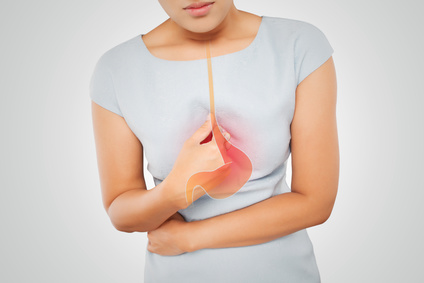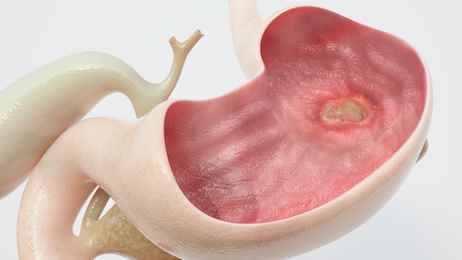Acidic Stomach Causes of Acidity, Symptoms, and Treatment
Acid is an integral part of the stomach’s function. Not only does the stomach produce acid but it also has mechanisms to hold it without being damaged. The stomach acid is essential for digesting food along with enzymes. However, excessive amounts of acid can also pose a problem. Similarly if the stomach’s mechanisms to safely contain the acid are compromised then the acid may damage the stomach.
What does acidic stomach mean?
The term ‘acidic stomach’ is often used to describe the various conditions associated with excessive stomach acid and the backward flow of this acid (reflux). It is a broad term attributed to conditions like gastritis, peptic ulcers and acid reflux. Typically an acidic stomach presents with a burning chest pain or burning abdominal pain, nausea, regurgitation or vomiting and/or stomach bloating, which is often described as indigestion (dyspepsia).
How does acid affect the stomach?
Gastric acid is not the only secretion from the stomach. Everyday the stomach produces approximately 1.5 liters of secretions. It is highly acidic due to the presence of hydrochloric acid. The stomach has mechanisms to deal with the acid – a mucus buffer protects the stomach lining from the action of the acid and increasing gastric emptying allows the contents to flow out of the stomach.
The duodenum is the first part of the small intestine that receives the partially digested acidic stomach contents known as gastric chyme. While the duodenum does not contain any protective layer against the acid, it does secrete alkaline bicarbonate ions and water to dilute and neutralize the incoming acid. In addition, the duodenum can secrete the digestive hormone, secretin, to reduce gastric acid production and secretion as well as delaying gastric emptying.
The esophagus, however, is not as well equipped to deal with the stomach acid. Normally, the acid should not flow backwards from the stomach into the esophagus – this is prevented by the lower esophageal sphincter (LES) and throat-to-rectum direction of peristaltic waves.
If the acidic stomach contents do enter the esophagus, excess saliva is secreted which is alkaline and neutralizes some of the acid. The peristaltic waves in the stomach increase to ‘flush’ the acid back into the stomach. An acidic stomach includes conditions that arise predominantly in these three areas – esophagus, stomach and duodenum – as a result of impaired stomach acid regulation.
Causes of Acidic Stomach
Acidic stomach is not a medical diagnosis. It is a way of describing conditions associated with too stomach acid or stomach acid that enters other parts of the gut, like the esophagus. This can be broadly discussed under three conditions:
- Acid reflux which is also known as gastroesophageal reflux disease (GERD).
- Gastritis
- Peptic ulcer disease
Acid Reflux
Acid reflux is where stomach acid enters the esophagus (food pipe). This injures and damages the wall of the esophagus. It leads to inflammation of the esophagus (esophagitis) and even open sores the esophagus (esophageal ulcers). Reflux is not uncommon. It occasionally affects every person from childhood till adulthood, especially with overeating, alcohol consumption, lying flat or exercising after heavy meals.
However, when reflux is persistent then it can lead to complications. Most of the time chronic reflux is not due to excessive acidity. Instead it is a problem with the lower esophageal sphincter (LES) which does not close properly. This sphincter would normally prevent stomach acid and enzymes from flowing backward into the esophagus.
Gastritis
Gastritis is inflammation of the stomach wall. It is a common condition where stomach acid irritates and injures the stomach lining. This happens when the mucus barrier that normally protects the stomach lining is compromised. The acid and enzymes can then make contact with the stomach tissue. These corrosive substances cause tissue damage.
The main causes of this is H.pylori infection and the excessive use of NSAIDs. H.pylori is a type of bacterium that can survive the stomach acid. It then burrows into the stomach wall and hampers the mucus barrier in this area. Excessive use of certain drugs like NSAIDs also disrupts the stomach lining’s production of mucus thereby leaving the stomach wall exposed.
Peptic Ulcers
Open sores can form in the esophagus, stomach or duodenum. These sores are known as ulcers. Peptic ulcer disease (PUD) are open sores that form in the upper digestive tract for the similar causes as gastritis. H.pylori infection is one of the main causes of these sores to form in the stomach and duodenal wall.
Symptoms of Acidic Stomach
Many of the symptoms of stomach acid problems may be similar and identifying subtle differences may help in diagnosing the most likely disorder. The common signs and symptoms include :
- Burning pain – chest (heartburn) or upper abdomen (stomach ache, stomach discomfort or gastric pain).
- Nausea and/or vomiting.
- Stomach bloating which is a sensation of fullness or pressure in the upper abdomen.
- Blood in the vomit (hematemesis) and blood in the stool (melena) are uncommon but may be a sign of upper gastrointestinal bleeding which is a complication of all three conditions.
More specific signs and symptoms include :
- Excessive belching may be present in all of the conditions but is more prominent in gastritis.
- Sudden accumulation of excessive saliva in the mouth (water brash) is more prominent in acid reflux.
- Constant hunger pangs or pain that exacerbates when hungry. It usually eases for a short period after eating may be a symptom of gastritis or a peptic ulcer.
- Chronic sore throat, especially a morning sore throat, is seen in acid reflux.
- Regurgitation is more frequently seen in acid reflux but may be reported in other hyperacidity conditions as well.
Treatment of Acidic Stomach
Antacids are the most commonly used treatment for acidic stomach symptoms. These substances neutralize the stomach acid. It includes substances like milk, baking soda and other alkaline foods or beverages. Commercial antacids are available as tablets, solutions and effervescents.
Antacids offer short term relief. If the condition is chronic or the symptoms do not ease with antacids then other medication may be used. The most common associated drug is a proton pump inhibitor. It reduces stomach acid production. Other drugs may be used to help speed up stomach emptying and to coat ulcers thereby allowing it to heal.






